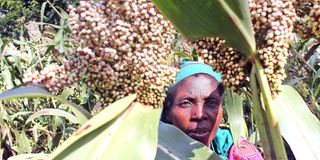To transform agriculture, put it at the centre of every sector

Suprose Atieno examines finger millet in her kitchen garden in Sidho, Muhoroni, Kisumu County. There is a reawakening towards healthy eating creating massive opportunties for the agriculture sector in production of fruits, vegetables and processing of fortified foods. PHOTO | FILE | NATION MEDIA GROUP
What you need to know:
- Under the Big Four drivers and enablers, Treasury has set aside Sh18.3 billion in support of value addition and to raise the manufacturing sector share of GDP to 15 per cent by 2022, Sh52.8 billion for enhancing food and nutrition security of all Kenyans and Sh50.3 billion for health.
- Agro-processing presents the country with the shortest route to jumpstart our once-thriving manufacturing sector.
- The Agriculture Sector Network (ASNET) was formed to put this thinking into a tangible process by bringing stakeholders to collectively own the journey within short and long-term goals.
- There are many other crops as well as numerous profitable agriculture activities the western sugarbelt can shift to gradually.
In its Mwananchi Guide, the National Treasury unpacks the 2020/2021 financial year budget, which was presented to Parliament last month.
Aptly, the budget is themed ‘Stimulating the economy to safeguard livelihoods, jobs, business and industrial recovery’.
Under the Big Four drivers and enablers, Treasury has set aside Sh18.3 billion in support of value addition and to raise the manufacturing sector share of GDP to 15 per cent by 2022, Sh52.8 billion for enhancing food and nutrition security of all Kenyans and Sh50.3 billion for health.
A closer look at the big spending in these three enablers reveals that agriculture sits right in the middle of the vote, essentially meaning that the success of the intervention lies squarely in the farming industry. Here’s how:
Kenya is basically an agricultural country, with 60 per cent of the economy falling in the sector.
For value addition and manufacturing to thrive, we must put more into producing the raw materials.
Agro-processing presents the country with the shortest route to jumpstart our once-thriving manufacturing sector.
In between the raw and the finished product is a whole chain of businesses, each benefiting from a grain of wheat farmed somewhere in Narok or a litre of milk produced in Kiambu.
We need fertilisers, farm chemicals, labour, farm tools, water for irrigation, farm machinery, transport, requisite technologies, sorting and processing machinery, packaging, financiers, wholesalers, retailers, mama mbogas and the consumers.
If one looks at the numbers of jobs created at every level of this chain, the full picture of the importance of the agriculture sector in economic transformation begins to shape up.
The Agriculture Sector Network (ASNET) was formed to put this thinking into a tangible process by bringing stakeholders to collectively own the journey within short and long-term goals.
It is, therefore, encouraging to see a budgetary allocation that resonates with the network’s thinking.
LION’S SHARE
For the longest time, there has been a disconnect between intent and practice and a time has come to join the two to move our country forward.
By the same token, food and nutrition security has been given the lion’s share of the Big Four allocation.
There is no need to belabour the point as it automatically translates to the need for a thriving agriculture sector.
Plainly put, there cannot be food and nutrition security without increased production and distribution of the food.
It is worth adding that zoning of the country’s agriculture regions becomes critical so that the full potential of a particular area can be tapped and produce distributed to areas producing less or not at all.
For instance, it has been argued that production of sugar in the western belt is not economically viable due to several geographical disadvantages.
Kenyan Coast would be the region to grow sugar within economic thresholds but for some reason, this subject has not been addressed despite studies explaining the situation.
There are many other crops as well as numerous profitable agriculture activities the western sugarbelt can shift to gradually.
Horticulture is taking root in the region, with demand for fruits and vegetables rising in the neighbouring Uganda, Democratic Republic of Congo and South Sudan, according to studies by various institutions.
The big spend allocated to health too has an aspect of agriculture. The argument here is the need for preventive than curative measures, of which eating healthy foods is common knowledge.
There is a reawakening towards healthy eating creating massive opportunties for the agriculture sector in production of fruits, vegetables and processing of fortified foods.
Put together, the Big Four drivers position the agriculture industry as the key enabler and driver.
EXPANDED NEED FOR FOOD
Do we have the infrastructure through which these billions will flow to the sector and unlock development?
As we ponder the answer to that question, there are more billions the agriculture industry can tap into.
Take for instance the Sh324 billion for infrastructure, Sh487 billion for education, Sh88 billion for poverty reduction and many more.
Agriculture value chains automatically create the need for roads and roads are known to open up development.
Opening up development translates to expanded need for food and increased farm production.
ducation, on the other hand, requires equiping young minds with skills and it is becoming imperative to include agriculture in the school curriculum at both primary and secondary levels.
Agriculture training and practice cannot be divorced in the new approach to agriculture transformation therefore the sector is a big beneficiary of the education budget.
Agriculture has increasingly embraced technology, where the youth are more involved, meaning part of the Sh14 billion for ICT is available for the sector.
On equity and poverty eradication, agriculture remains the biggest employer especially in the rural areas.
Increased production will translate to increased earnings, job creation and poverty eradication, giving agriculture a bite of the Sh88 billion.
If we go deeper and incorporate the environment to agriculture, then there are still more billions linked to this sector.
Floods control and water harvesting with Sh78 billion spend has an aspect of agriculture.
Whichever way we look at it, the agriculture sector must be positioned, not as a driver of economic stimulation, but the centre pivot.
Any weakness in the pivot will slow down the process. It is this school of thought that the crafters and implementers of the agriculture transformation must pursue if Kenya’s economy is purposed to turn-around.
The writer is the Agriculture Sector Network (ASNET) technical adviser.


